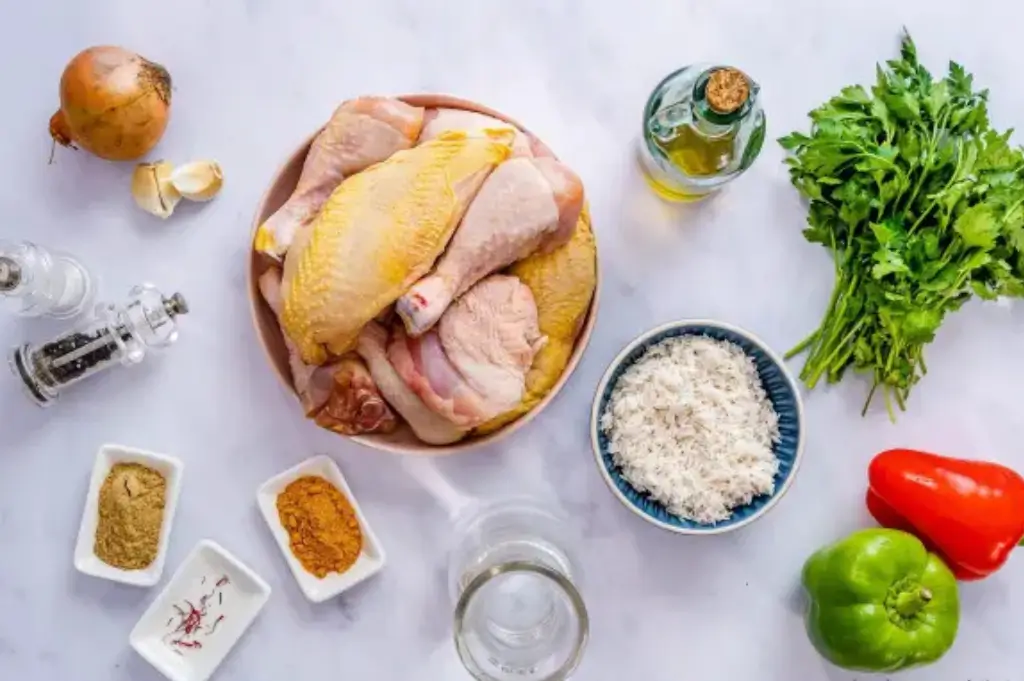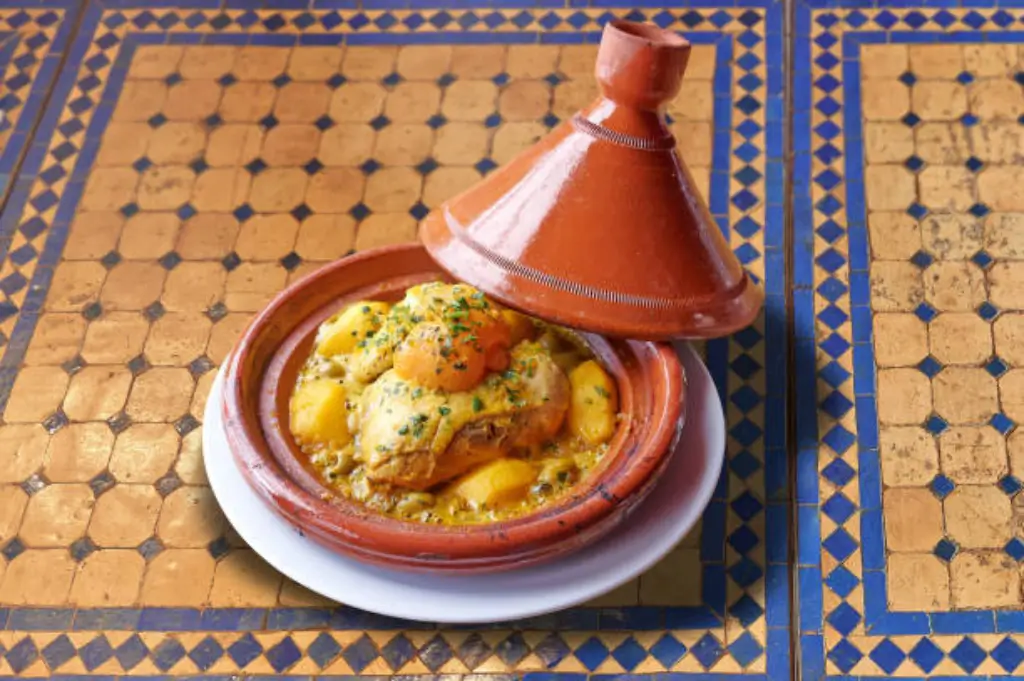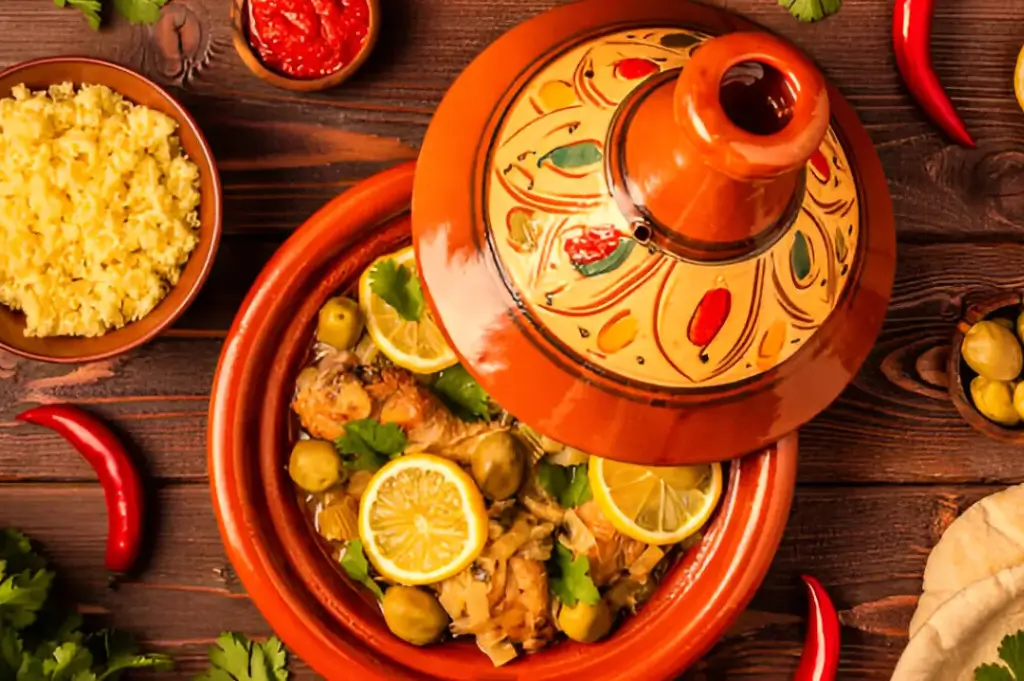Moroccan Chicken Tagine: The Ultimate Guide to Morocco’s Most Beloved Dish
When you think of Moroccan Chicken Tagine, you’re envisioning more than just a meal—you’re imagining centuries of culinary tradition simmering in an iconic clay pot. This aromatic masterpiece represents the heart of North African cuisine, where tender chicken mingles with exotic spices, dried fruits, and vegetables to create a symphony of flavors that has captivated food lovers worldwide.
The art of preparing authentic tagine dishes has been passed down through generations of Moroccan families, each adding their own signature touch to this timeless recipe. Whether you’re a seasoned home cook or just discovering the magic of best moroccan food, this comprehensive guide will transform your kitchen into a Marrakech spice market.
Table of Contents
The Rich History Behind Morocco’s Iconic Tagine
The tagine takes its name from the distinctive conical clay pot in which it’s traditionally cooked. This ingenious cooking vessel, with its cone-shaped lid, creates a natural steam circulation system that keeps ingredients moist while concentrating flavors. Archaeological evidence suggests that similar cooking methods have been used in North Africa for over 3,000 years, making moroccan chicken preparations one of the world’s oldest culinary traditions.
Berber tribes originally developed this slow-cooking technique as a practical solution for preparing meals during long desert journeys. The self-contained cooking system required minimal water while maximizing flavor—a necessity in the arid landscapes of Morocco. Today, chicken tagine dishes remain a cornerstone of Moroccan hospitality, often served during special occasions and family gatherings.
Essential Spices: The Soul of Every Tagine
The magic of Moroccan Chicken Tagine lies in its complex spice blend, dominated by the legendary ras el hanout chicken seasoning. This “top of the shop” spice mixture can contain anywhere from 10 to 30 different spices, each contributing to the dish’s distinctive flavor profile.
Key Tagine Spices You Need:
Ras el Hanout: This is the crown jewel of tagine spices, typically including cumin, coriander, cinnamon, ginger, turmeric, cardamom, cloves, and rose petals. Each spice merchant has their own secret blend, making every ras el hanout chicken dish unique.
Saffron: Often called “red gold,” saffron imparts a luxurious golden color and delicate floral aroma that elevates any tajin chicken preparation.
Ginger and Cinnamon: These warming spices provide the earthy sweetness that balances the savory elements in traditional moro chicken recipes.
Preserved Lemons: While technically not a spice, these salt-cured citrus gems add a bright, tangy complexity that’s essential to authentic Moroccan flavors.

The Perfect Moroccan Chicken Tagine Recipe
Creating an authentic Moroccan Chicken Tagine requires patience, quality ingredients, and respect for traditional techniques. This recipe serves 6-8 people and takes approximately 2.5 hours to prepare and cook.
Ingredients:
- 3 lbs chicken, cut into serving pieces (thighs and drumsticks work best)
- 2 large onions, sliced
- 4 cloves garlic, minced
- 2 tbsp ras el hanout spice blend
- 1 tsp ground ginger
- 1 tsp ground cinnamon
- 1/2 tsp saffron threads
- 2 preserved lemons, quartered
- 1 cup mixed olives (green and kalamata)
- 1 cup dried apricots
- 2 tbsp olive oil
- 2 cups chicken broth
- Salt and pepper to taste
- Fresh cilantro and mint for garnish
Preparation Method:
Step 1: Season and Marinate Rub the chicken pieces with tagine spices, including half the ras el hanout, salt, and pepper. Allow to marinate for at least 30 minutes, though overnight marination produces superior results.
Step 2: Build the Flavor Base In your tagine pot (or heavy-bottomed Dutch oven), heat olive oil over medium heat. Brown the marinated chicken pieces on all sides, creating a beautiful golden crust that locks in flavors.
Step 3: Create the Aromatic Foundation Remove chicken and sauté onions until translucent. Add garlic, remaining ras el hanout, ginger, and cinnamon, cooking until fragrant—about 2 minutes. This step releases the essential oils in the spices, intensifying their impact on the final dish.
Step 4: Slow Cooking Magic Return chicken to the pot, add saffron (bloomed in 2 tablespoons warm broth), preserved lemons, and enough chicken broth to partially cover the ingredients. Cover and simmer on low heat for 1.5 hours.
Step 5: Final Flourishes Add dried apricots and olives during the last 30 minutes of cooking. This timing prevents the apricots from becoming mushy while allowing them to absorb the rich sauce flavors.
Regional Variations: Exploring Different Styles
Morocco’s diverse regions have created numerous interpretations of chicken tagine dishes, each reflecting local ingredients and preferences.
Chicken and Apricot Tagine (Marrakech Style)
The chicken and apricot tagine represents the sweet-savory tradition of imperial Marrakech cuisine. This variation emphasizes the interplay between dried fruits and warming spices, creating a dish that’s both comforting and exotic. The natural sugars in apricots caramelize during the slow-cooking process, creating a glossy, amber-colored sauce.

Coastal Variations
Along Morocco’s Atlantic coast, moroccan chicken preparations often incorporate olives and preserved lemons more prominently, reflecting the Mediterranean influence on local cuisine. These versions tend to be more citrus-forward and pair beautifully with seafood-based side dishes.
Mountain Tagines
In the Atlas Mountains, moro chicken recipes frequently include heartier vegetables like carrots, turnips, and potatoes, making them more substantial for the harsh mountain climate.
Mastering the Traditional Tagine Pot
While modern cookware can produce delicious results, cooking in an authentic clay tagine pot elevates the entire experience. The porous clay adds subtle earthy notes to the dish while the conical lid design ensures even heat distribution and moisture retention.
Seasoning Your Tagine
Before first use, soak your new tagine in water for 24 hours, then rub with olive oil and bake at 300°F for 2 hours. This process strengthens the clay and prevents cracking during cooking.
Care and Maintenance
Never expose a clay tagine to sudden temperature changes. Always start cooking over low heat and gradually increase temperature. Hand wash with warm water and mild soap, avoiding harsh detergents that can strip the seasoning.
Perfect Pairings and Serving Suggestions
Moroccan Chicken Tagine shines brightest when served with traditional accompaniments that complement its rich, complex flavors.
Essential Side Dishes:
Fluffy Couscous: The tiny pasta pearls are perfect for absorbing the tagine’s aromatic sauce. Steam couscous with a touch of butter and salt for the most authentic presentation.
Moroccan Bread (Khobz): This round, flat bread is ideal for scooping up sauce and tender meat. Its slightly chewy texture provides a pleasant contrast to the succulent chicken.
Harissa: This spicy chili paste adds heat and complexity for those who enjoy more intense flavors.
Health Benefits of Tagine Cooking
The slow-cooking method used in tajin chicken preparation offers numerous nutritional advantages. The gentle, moist heat preserves vitamins and minerals while breaking down tough connective tissues, making the meat incredibly tender and digestible.
The abundant use of anti-inflammatory spices like turmeric, ginger, and cinnamon provides significant health benefits. These tagine spices have been used medicinally for centuries and modern research confirms their antioxidant and anti-inflammatory properties.
Modern Adaptations for Today’s Kitchen
Contemporary home cooks can adapt traditional moro chicken recipes for modern conveniences without sacrificing authenticity. Slow cookers, pressure cookers, and even oven-braising methods can produce excellent results when proper techniques are applied.
Slow Cooker Method:
Follow the same preparation steps, but transfer everything to a slow cooker after browning the chicken and building the spice base. Cook on low for 6-8 hours or high for 3-4 hours.
Pressure Cooker Adaptation:
Using an Instant Pot or similar device, you can achieve tender results in about 45 minutes, though some argue the flavors don’t develop as fully as with traditional slow cooking.
Wine and Beverage Pairings
The complex flavors of Moroccan Chicken Tagine pair beautifully with both traditional Moroccan beverages and international wines.
Traditional Options: Mint tea remains the classic accompaniment, its refreshing qualities cleansing the palate between rich bites.
Wine Pairings: Medium-bodied red wines like Côtes du Rhône or Moroccan reds complement the spice complexity, while off-dry Rieslings balance the sweetness from dried fruits.
Storing and Reheating Tips
Like many slow-cooked dishes, chicken tagine dishes often taste even better the next day as flavors continue to meld and develop. Store leftovers in the refrigerator for up to 4 days or freeze for up to 3 months.
When reheating, add a splash of broth to prevent drying out and warm gently over low heat to preserve the delicate spice balance.
Conclusion: Embracing Morocco’s Culinary Heritage
Mastering Moroccan Chicken Tagine opens doors to understanding North African culinary philosophy, where patience, quality ingredients, and time-honored techniques create extraordinary results. This iconic dish represents more than sustenance—it’s a celebration of community, tradition, and the transformative power of slow cooking.
Whether you’re preparing your first tagine or perfecting family recipes passed down through generations, remember that each pot tells a story. The aromatic steam rising from your kitchen carries the essence of Moroccan markets, family gatherings, and centuries of culinary wisdom.
The next time you lift the conical lid of a tagine pot, take a moment to appreciate not just the incredible aromas and flavors, but the rich cultural heritage simmering within. Your Moroccan Chicken Tagine is more than dinner—it’s a delicious journey through time and tradition, one perfectly spiced bite at a time.







